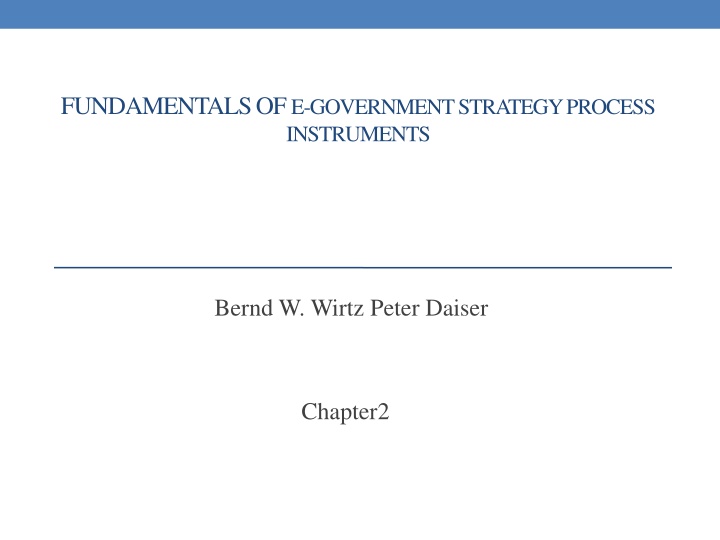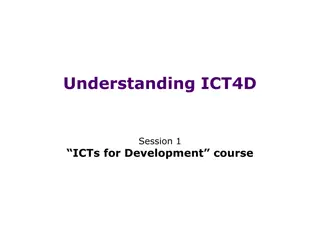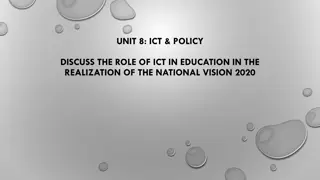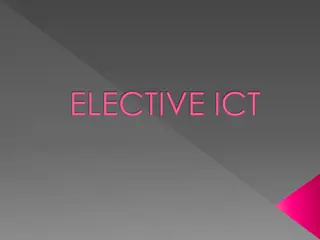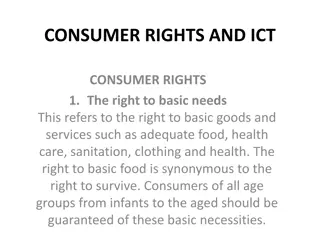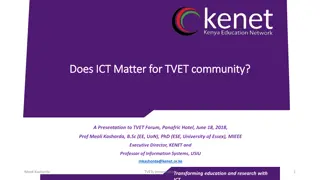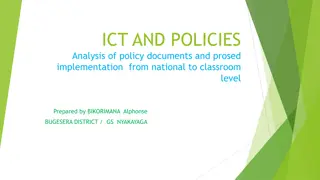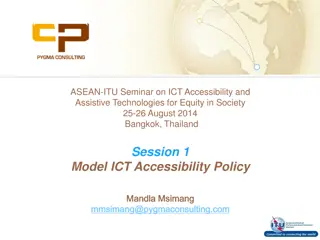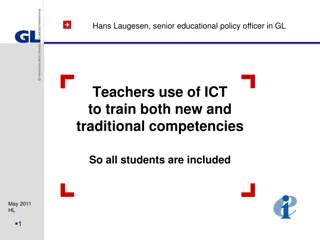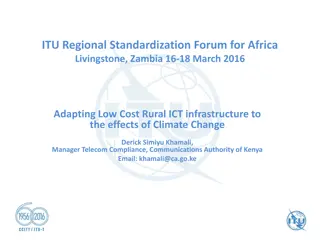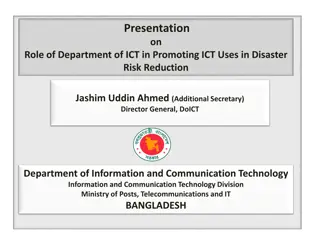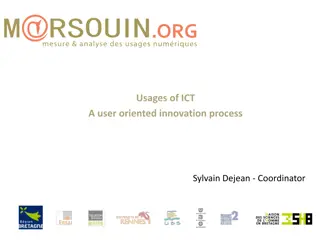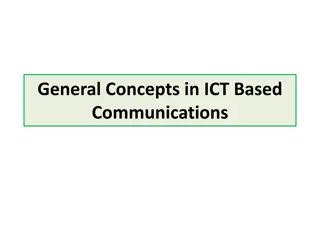Evolution of Information Society through ICT Development
The development of Information and Communication Technologies has shaped the information society, leading to significant social transformations globally. Key milestones in technology evolution from IBM's DOS to Google, online music distribution, and social networks have had a profound impact on societies worldwide.
Download Presentation

Please find below an Image/Link to download the presentation.
The content on the website is provided AS IS for your information and personal use only. It may not be sold, licensed, or shared on other websites without obtaining consent from the author.If you encounter any issues during the download, it is possible that the publisher has removed the file from their server.
You are allowed to download the files provided on this website for personal or commercial use, subject to the condition that they are used lawfully. All files are the property of their respective owners.
The content on the website is provided AS IS for your information and personal use only. It may not be sold, licensed, or shared on other websites without obtaining consent from the author.
E N D
Presentation Transcript
FUNDAMENTALS OF E-GOVERNMENT STRATEGY PROCESS INSTRUMENTS Bernd W. Wirtz Peter Daiser Chapter2
The Development of Information and Communication Technologies To understand the underlying evolution of the information society, we have to take a look at the Information and Communication Technology (ICT) development: In 1966 IBM introduced the Disk Operating System (DOS) for its mainframes. This was the first system that allowed batch processing. Based on these previous steps, IBM introduced the first personal computer and Motorola presented the first commercial mobile phone.
Figure 5 Information and Communication Technology Development
The Development of Information and Communication Technologies 1998 was the founding year of Google Inc., an Internet business that started as a search engine Deutsche Telekom started marketing broadband connections and in 2001 Manx Telecom introduced the first UMTS network on the Isle of Man. This technology is regarded as a milestone in mobile Internet. A milestone in online music distribution, for example, was the media library and player iTunes, which was released in 2001 and soon became the leading portal in digital music marketing Moreover, completely new services like Facebook, an online social network, were suddenly realizable.
The information Society and its Development The world entered a new technological paradigm by making use of globally networked information and communication technologies. This is a key reason for a set of related social transformations that have taken place all around the world during the past three decades. Although these transformations partly have taken distinct forms and show different manifestations ( ) due to varying cultural and historical characteristics, they nowadays fundamentally affect a vast majority of societies.
The information Society and its Development The new economy we are living in is characterized by the following three features: 1. It is informational, meaning that information management and knowledge creation capacities are main determinants for competitiveness for all economic participants. 2. It is global, in the sense that economic units can communicate and coordinate their strategic and operative activities in real time on a global scale. 3. It is networked, meaning that economic units are interconnected, which allows the network enterprise to develop a new form of organization.
E-Government Development Applying new information and communication technologies to the public sector environment promised to enhance public administration productivity and to satisfy citizen demands for online information and service provision. This was the starting point for an increasing integration of these technologies into governance systems and processes and public authorities began to digitally provide information and services to citizens and businesses. This novel form of service provision was called electronic government or e-government that based on its innovative nature and expected potential quickly received increasing attention in the public administration and management practice as well as in science (Dawes 2009).
E-Government in Practice In 2001 the e-Japan Priority Policy Program was started, which aimed to create the world s most advanced information and telecommunications network. Key targets of this program were: 1. The promotion of education, learning, and human resources development 2. The facilitation of electronic commerce 3. The digitization of public administration and management areas.
E-Government in Practice In 2008 South Korea established the Master Plan for National Informatization, which consists of 12 e-government improvement initiatives. These initiatives aim to further enhance the openness, sharing, and cooperation of the Korean e- government environment List of top 20 of the most developed countries in the field of information and communication technology in the world.
E-Government in Practice This list is based on the ICT (information and communication technologies) Development Index (IDI), which combines 11 indicators into a single standard measure and is applied to monitor, compare, and evaluate information and communication technology developments across countries over time. The 11 indicators are made up of three subgroups: 1. Five indicators measure ICT readiness, which reflects the availability of fixed and mobile Internet access 2. Three indicators measure ICT intensity, which reflects a country s Internet usage and broadband subscriptions 3. Three indicators measure ICT capability/skills, which reflects a country s literacy rate ( ) and educational level
E-Government in Practice Five indicators measure ICT readiness ( the availability of fixed and mobile Internet access: Fixed-telephone subscriptions per 100 inhabitants Mobile-cellular telephone subscriptions per 100 inhabitants International Internet bandwidth (bits/s) per user Percentage of households with a computer Percentage of households with internet access. Three indicators measure ICT intensity, which reflects a country s Internet usage and broadband subscriptions Percentage of individuals using the Internet Fixed (wired)-broadband subscriptions per 100 inhabitants Wireless broadband subscriptions per 100 inhabitants , which reflects ( 1. 2. 3. 4. 5. 1. 2. 3.
E-Government in Practice 1. Three indicators measure ICT capability/skills, which reflects a country s literacy rate ( ) and educational level Mean years of schooling the percentage of population aged 15 years and over who can both read and write with understanding a short simple statement on his/her everyday life. Generally, literacy also encompasses numeracy , the ability to make simple arithmetic calculations. Gross enrolment ratio the total enrolment in a specific level of education, regardless of age, expressed as a percentage of the eligible official school-age population corresponding to the same level of education in a given school-year. 1. Secondary gross enrolment ratio 2. Tertiary gross enrolment ratio 1. 2.
E-Government in Practice The European Commission s Digital Agenda proposes to better exploit information and communication technology benefits and potentials to foster innovation and economic growth. The Digital Agenda aims to reduce barriers that block a free flow of information and digital services as well as updating relevant market rules within the European Union (European Commission 2015a). The Digital Agenda forms the first of the seven Europe 2020 strategy pillars ( ( : 1. Digital single market 2. Interoperability ( ) and standards 3. Trust & security 4. Fast and ultra-fast Internet access 5. Research and innovation 6. Enhancing digital literacy, skills and inclusion 7. ICT-enabled benefits for the society ) (
E-Government in Practice Key factors for a high e-government development (United Nations 2014) based on the results of the past United Nations e- government studies 1. General level of economic, social, and political development of the countries 2. The investment in telecommunication, human capital, and online services provision
E-Government Research Although, novel information and communication technologies have been utilized by governments for nearly 30 years now, the technological breakthrough just took place after the millennium with wide distribution of Internet access and the availability of modern online applications (Andersen et al. 2010). A database query that was conducted in May 2015 resulted in a total of 3.249 relevant publications, of which 1.889 were published in peer reviewed and 1.360 in non-peer reviewed scientific journals. As mentioned above, scientific e-government picked up speed after the millennium.
E-Government Research So far, approximately six out of ten studies are of empirical nature. Therefore, the majority of scientific investigations collected evidence from reality to deduce theoretical findings. Although academic investigations peaked in the period between 2003 and 2005, there is still a high amount of scientific research compared to other academic disciplines. Figure 9 provides an overview of the number of e- government publications and shows the methodological split concerning empirical and conceptual research.
E-Government Research In this context, e-government research has taken various research directions, which have been investigated from a user or provider perspective.
E-Government Research Benchmarking-oriented studies often compare different e- government solutions or analyze e-government maturity states across borders. Studies dealing with benefits, potentials, and impact may investigate e-government activities concerning the outcome of IT implementation on public sector capabilities, interactions, orientations, and value distributions (Andersen et al. 2010). Satisfaction and trust-related studies examine these or similar conditions from a user or provider perspective, identifying, for instance, which portal characteristics foster or impede citizen satisfaction when using the e-government interface. The usual goal of success factor and barrier-related investigations is the identification and evaluation of aspects that promote or hinder implementation or use of e-government technology.
E-Government Research In the e-government sub-field system and technology, information system-relevant factors and technology-related aspects are analyzed for the most part. The user behavior-oriented field of e-government research is normally dedicated to investigations of citizens and their manner of conducting themselves when using e-government systems.
